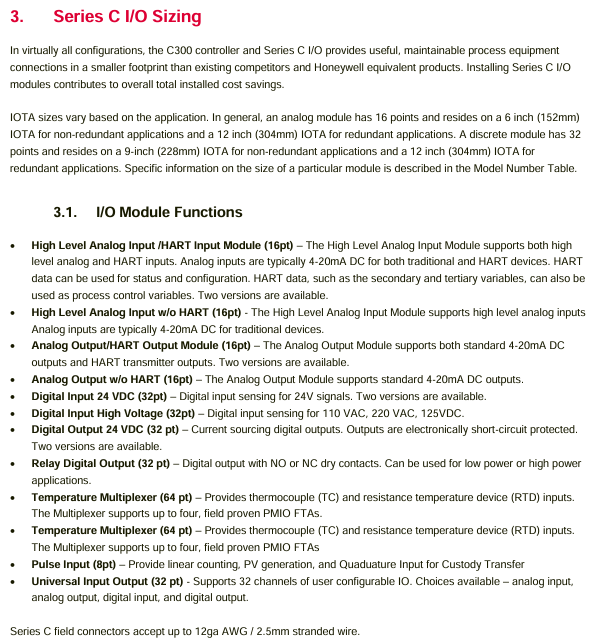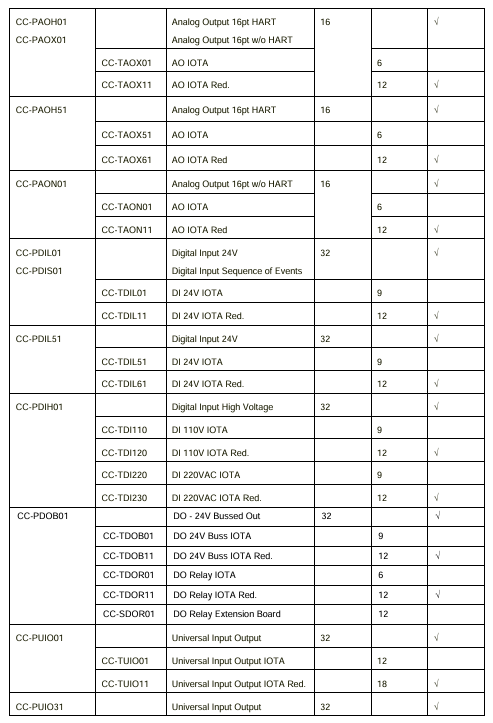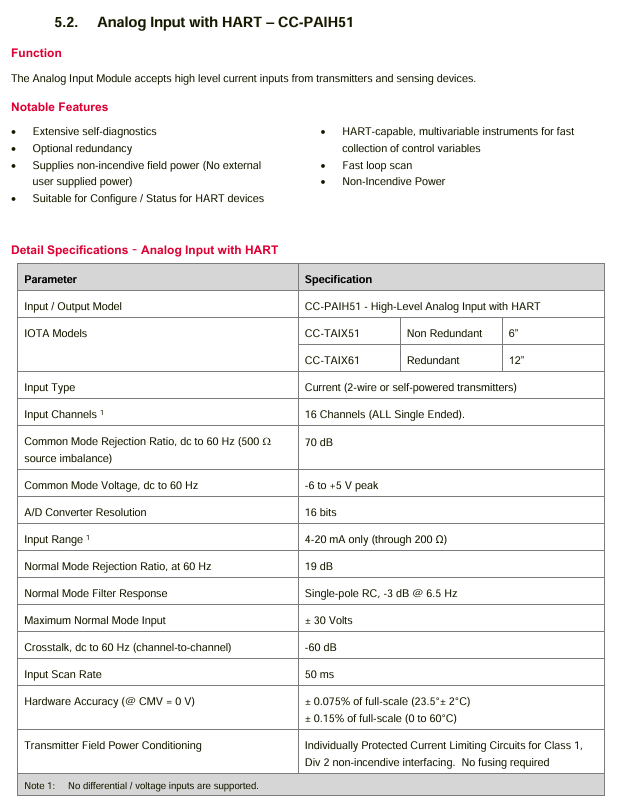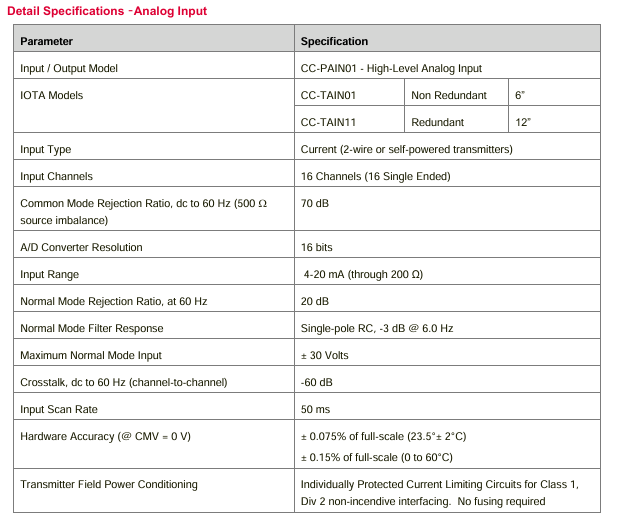

K-WANG


Honeywell Expert Series-C I/O Module
Scope of application: Expert Series-C I/O modules and C300 controllers, supported since the Expert R300 version
Core component definition:
IOTA (Input Output Termination Assembly): A component that integrates I/O module fixation and on-site wiring functions. The module is directly plugged into IOTA without the need for an additional chassis
IOM (Input Output Module): A module equipped with core electronic components to achieve specific I/O functions and obtain power from IOTA
Honeywell Expert Series-C I/O Module
Basic Information
Document ID: EP03-490-520, Release 520, Version 1.5
Scope of application: Expert Series-C I/O modules and C300 controllers, supported since the Expert R300 version
Core component definition:
IOTA (Input Output Termination Assembly): A component that integrates I/O module fixation and on-site wiring functions. The module is directly plugged into IOTA without the need for an additional chassis
IOM (Input Output Module): A module equipped with core electronic components to achieve specific I/O functions and obtain power from IOTA
Core functions and design highlights
1. Universal design advantages
Compact integrated architecture: IOM and field terminals are integrated into IOTA, eliminating the need for independent electronic component chassis, significantly reducing device size, and improving cabinet space utilization
Convenient wiring and maintenance: using two-level "separable" terminals, convenient for on-site wiring installation and later maintenance; Supports up to 12AWG (2.5mm ²) multi strand wire access
Simplified power supply and redundancy: The on-site power supply is provided through IOTA, eliminating the need for additional power and manual wiring; Redundant configuration only requires adding a second IOM on IOTA, without the need for external cables or control devices
Efficient heat dissipation and layout:
Vertical installation design: Suitable for scenarios where on-site wiring is connected from the top/bottom of the cabinet
Tilted structure: optimizes air circulation inside the cabinet, improves heat dissipation efficiency, and adapts to high-density installation requirements
Information Ring "Identification: Quickly guide maintenance personnel to view equipment status information
Built in protection mechanism: Input/output circuits have short-circuit protection, no need to connect fuses in series, reducing installation and maintenance costs
2. IOTA multifunctional integration
IOTA serves as the core carrier, integrating multiple functions and reducing external component dependencies
Support switching between single module and redundant module configurations
Built in process signal termination and signal conditioning functions
Directly connect to networks such as FTE, I/O LINK, etc
Realize on-site power distribution without the need for external wiring grouping
Provide stable power supply for the inserted IOM

Module Classification and Key Specifications
The Series-C I/O module covers 8 major categories of signal processing requirements, with different modules focusing on parameters such as channel quantity, input/output range, and accuracy. The core classifications and representative module specifications are as follows:
1. Analog input module (AI)
Mainly used to receive current/voltage signals from transmitters or sensors, with some supporting the HART protocol for device configuration and status monitoring.
Module model, core function, channel number, input type/range, key characteristics
CC-PAIH01/02 with HART protocol 16 current (4-20mA), voltage (0-5V/1-5V/0.4-2V) 12 single ended+4 differential channels, supports open circuit detection, Class 1 Div 2 non flammable power supply
CC-PAIH51 with HART protocol 16 current only (4-20mA, 200 Ω load) full single ended channel, no voltage/differential input, supports HART device configuration
CC-PAIX01/02 does not have HART protocol. The current (4-20mA) and voltage (0-5V/1-5V/0.4-2V) are consistent with the parameters of CC-PAIH01/02 and do not have HART function
CC-PAIN01 without HART protocol 16 only current (4-20mA, 200 Ω load) full single ended channel, non flammable power supply, suitable for basic current signal acquisition
2. Temperature input module
Specially designed for thermocouples (TC) and thermistors (RTD), supporting low-temperature drift and high-precision temperature measurement.
Module model, core function, number of channels, support for sensor types, key characteristics
CC-PAIM01 (LLMUX) temperature multiplexing 64 (16 channels/FTU) TC (J/K/E/T/B/S/R, etc.), RTD (Pt100/Ni120/Cu10) need to be matched with PMIO FTA, support remote cold end compensation, 1-second scanning cycle
CC-PAIL51 low-level temperature input 16 TC/RTD (configurable per channel) directly integrated into Series-C IOTA, no external FTA required, operating temperature from -40 to+70 ℃
3. Pulse Input Module (PI)
Used for processing pulse generation equipment signals, suitable for measurement and trade handover scenarios, supporting high-precision frequency and cycle measurements.
Module model CC-PPIX01
Number of channels: 8 single channels/4 dual channels (can be mixed configuration)
Frequency range: Single channel 0-100kHz, dual channel 0-10kHz
Accuracy within the range of 0.5Hz-100kHz, ± 0.001% reading error
Key features support MeterSuite trade handover application, compliant with ISO 6551 standard, with "quick cut-off" function (1ms delay)
4. Analog Output Module (AO)
Output stable current signals to actuators and recorders, with partial support for HART protocol and configurable fault safety status.
Module model, core function, channel number, output range, key characteristics
CC-PAOH01/51 with HART protocol 16 4-20mA support FAILOPT (maintain last value/switch to safe value), open circuit detection, accuracy ± 0.35% of full range at 25 ℃
CC-PAOX01/PAON01 without HART protocol 16 4-20mA and with HART module parameters consistent, without HART communication function, maximum load 800 Ω (24V power supply)
5. Digital Input Module (DI)
Receive discrete voltage signals, adapt to different voltage levels, and partially support sequence of events (SOE) recording.
Module model, voltage level, channel number, key characteristics
CC-PDIL01/51 24VDC 32 CC-PDIL01 supports open circuit detection and isolation voltage of 1500VAC; CC-PDIL51 has no open circuit detection and is isolated from 1000VAC
CC-PBIS01 24VDC 32 supports SOE (1ms resolution), three scanning modes (normal 20ms/fast 5ms/SOE mode)
CC-PDIH01 high voltage (110VAC/220VAC/125VDC) 32 is compatible with different high voltage signals, and can switch voltage types by replacing IOTA, reducing the variety of spare parts
6. Digital Output Module (DO)
Output discrete signals to control external devices (such as solenoid valves, intermediate relays), with short-circuit protection and fault safety configuration.
Module model, output type, number of channels, key characteristics
CC-PDOB01 24VDC bus type (source output) 32 no fuse short circuit protection, supports FAILOPT, maximum 0.5A per channel, maximum 6A per module
CC-PDOB01 (relay IOTA) dry contact (NO/NC configurable) 32 with CC-TDOR01/11 IOTA, maximum contact 250VAC/125VDC, mechanical life 5 million times
CC-PDOD51 24VDC current output with 32 coating protection, maximum 0.1A per channel, isolation voltage 1000VAC
7. Universal Input/Output Module (UIO)
Single module supports multiple types of signal configurations, with high flexibility and adaptability to complex mixed signal scenarios.
Module model, channel number, configurable type, key characteristics
CC-PUIO01 32 AI/AO/DI/DO/pulse input (15-18 channels) supports HART 7, -40 to+70 ℃ working temperature, electronic short circuit protection
CC-PUIO31 32 AI/AO/DI/DO/SOE/pulse input (any 4-channel) HART channel independent modem, SOE 1ms resolution, pulse frequency 0-15kHz

IOTA size and compatibility configuration
The size of IOTA varies with module type (analog/digital) and redundancy requirements. Non redundant configurations have smaller sizes, while redundant configurations require longer IOTA. The specific adaptation relationship is as follows (excerpt from core combinations):
IOM type non redundant IOTA model non redundant size (inches) redundant IOTA model redundant size (inches) number of channels
Analog Input (AI) CC-TAIX01 6 CC-TAIX11 12 16
Temperature input (LLMUX) CC-TAIM01 6-64 (FTA required)
Pulse Input (PI) - CC-TPIX11 12 8
Analog Output (AO) CC-TAOX01 6 CC-TAOX11 12 16
Digital input (24VDC) CC-TDIL01 9 CC-TDIL11 12 32
Universal Input Output (UIO) CC-TUIO31 9 CC-TUIO41 12 32
Installation and safety regulations
1. Installation requirements
Module positioning: IOM needs to be plugged into the corresponding IOTA, which is fixed to the 24VDC bus power supply rail of the cabinet with screws
Wiring specifications:
Wire specifications: It is recommended to use copper wire with a rated temperature of 75 ℃, and a single terminal can support 2 wires of the same specification or 1 maximum 12AWG wire
Stripping length: Unified at 0.25 inches (7mm), excessive length may result in exposed wires and pose a risk of electric shock
Noise protection: Ensure that the module installation screws are tightened and grounded according to specifications; The noise reduction gasket on the right side of the module (both sides of the power module) should be in contact with adjacent modules/cabinets to avoid electromagnetic noise interference
2. Installation requirements for hazardous areas
For Class I Zone 2 hazardous environments, the following regulations must be followed:
Only applicable to Class I Zone 2 A/B/C/D hazardous areas or non hazardous areas, and cannot be used for other hazardous level scenarios
It is prohibited to replace module components, otherwise it may damage the explosion-proof applicability
Before power outage or confirming the safety of the area, it is forbidden to disconnect the equipment connection to avoid the risk of explosion

Ordering Information (Core Components)
In addition to the IOM module, matching IOTA and fan components need to be selected based on the number of cabinet slots and power supply type. Some key models are as follows:
Product Description Model
16 channel with HART analog input module CC-PAIH01
32 channel 24VDC digital input module CC-PDIL01
32 channel 24VDC bus type digital output module CC-PDOB01
32 channel universal input/output module CC-PUIO31
17 slot cabinet 120VAC fan component IC697ACC721
17 slot cabinet 24VDC fan component IC697ACC744
9-slot cabinet 240VAC fan component IC697ACC624
Supplementary explanation
Environmental specifications: The temperature and humidity tolerance, vibration and impact and other environmental parameters of the module should refer to the "Series-C Platform Specifications" and technical document EP03-520-xxx
Compliance certification: FCC, EU directives and other compliance information, please refer to Appendix A of the "Expert RX7i Installation Manual" (GFK-2223)
Maintenance suggestion: Regularly check the tightness of IOTA terminal wiring, module temperature, and LED status. In case of faults, prioritize using the "information ring" and LED to determine the type of problem (such as open circuit, short circuit, overheating)

- YOKOGAWA
- Energy Access
- Renewable Integration
- Energy Subsidies
- Energy and Water
- Net zero emission
- Energy Security
- Critical Minerals
- A-B
- petroleum
- Mine scale
- Energy and Gender
- Covid-19
- man-machine
- Reliance
- ADVANCED
- SEW
- ProSoft
- WATLOW
- Kongsberg
- FANUC
- VSD
- DCS
- PLC
- Sewage treatment
- cement
- Yaskawa
- Woodward
- BOSCH Rexroth
- MOOG
- General Electric
- American NI
- Rolls-Royce
- CTI
- Honeywell
- EMERSON
- Automobile market
- xYCOM
- Motorola
- architecture
- Industrial information
- New energy
- electricity
- Construction site
- HIMA
- ABB
- Rockwell
- Schneider Modicon
- Siemens
- MAN
- GE
- TRICONEX
- Control Wave
- ALSTOM
- AMAT
- STUDER
- KONGSBERG
- MOTOROLA
- DANAHER MOTION
- Bentley
- Galil
- EATON
- MOLEX
- Triconex
- DEIF
- B&W
- ZYGO
- Aerotech
- DANFOSS
- KOLLMORGEN
- Beijer
- Endress+Hauser
- schneider
- Foxboro
- KB
- REXROTH
- YAMAHA
- Johnson
- Westinghouse
- WAGO
- TOSHIBA
- TEKTRONIX
- BENDER
- BMCM
- SMC
-
GE Hydran M2-X Enhanced Monitoring
-
ABB REG316 1mrk000809-GA Numerical Generator Protection
-
ABB RED670 1MRK004810 Line differential protection
-
GE SR750-P5-G5-S5-HI-A20-R-E Feeder protection system
-
ABB PFTL301E-1.0KN 3BSE019050R1000 PillowBlock Load cells
-
Kollmorgen S33GNNA-RNNM-00 - Brushless Servo Motor
-
Kollmorgen 6sm56-s3000-g-s3-1325 - Servo Motor
-
Kollmorgen AKM52K-CCCN2-00 - Servo Motor
-
Kollmorgen PSR3-230/75-21-202 - Power Supply
-
Kollmorgen akm24d-anc2r-00 - Servo Motor
-
Kollmorgen AKM22E-ANCNR-00 - Servo Motor
-
Kollmorgen S60300-550 - Servo Drive
-
Kollmorgen B-204-B-21 - Servomotor
-
Kollmorgen AKM21E-BNBN1-00 - Servo Motor
-
Kollmorgen TT2953-1010-B - DC Servo Motor
-
Kollmorgen pa8500 - Servo Power Supply
-
Kollmorgen BDS4A-210J-0001-207C2 - Servo Drive
-
Kollmorgen TTRB1-4234-3064-AA - DC Servo Motor
-
Kollmorgen MH-827-A-43 - Servo Motor
-
Kollmorgen AKM24D-ACBNR-OO - Servo Motor
-
Kollmorgen 00-01207-002 - Servo Disk DC Motor
-
Kollmorgen AKM21C-ANBNAB-00 - Servo Motor
-
Kollmorgen PSR3-208/50-01-003 - Power Supply
-
Kollmorgen 6SM56-S3000 - Servo Motor
-
Kollmorgen DBL3H00130-B3M-000-S40 - Servo Motor
-
Kollmorgen 6SN37L-4000 - Servo Motor
-
Kollmorgen AKM65K-ACCNR-00 - Servo motor
-
Kollmorgen 6SM56-L3000-G - Servo Motor
-
Kollmorgen AKMH43H-CCCNRE5K - Servo Motor
-
Kollmorgen PSR4/52858300 - Power Supply
-
Kollmorgen KBM-79H03-E03 - Direct Drive Rotary Motor
-
Kollmorgen AKM33E-ANCNDA00 - Servo Motor
-
Kollmorgen U9M4/9FA4T/M23 - ServoDisc DC Motor
-
Kollmorgen AKM13C-ANCNR-00 - Servo Motor
-
Kollmorgen AKM43L-ACD2CA00 - Servo Motor
-
Kollmorgen AKM54K-CCCN2-00 - Servo Motor
-
Kollmorgen M-605-B-B1-B3 - Servo Motor
-
Kollmorgen AKD-P00606-NBAN-0000 - Rotary Drive
-
Kollmorgen 6SM-37M-6.000 - Servo Motor
-
Kollmorgen A.F.031.5 - Sercos Interface Board
-
Kollmorgen 918974 5054 - Servo PWM
-
Kollmorgen U12M4 - ServoDisc DC Motor
-
Kollmorgen AKD-B00606-NBAN-0000 - Servo Drive
-
Kollmorgen MV65WKS-CE310/22PB - Servo Drive
-
Kollmorgen 65WKS-CE310/22PB - Servo Drive
-
Kollmorgen EM10-27 - Module
-
Kollmorgen S64001 - Servo Drive
-
Kollmorgen CR03200-000000 - Servo Drive
-
Kollmorgen 6SM57M-3000+G - Servo Motor
-
Kollmorgen BDS4 - Servo Drive
-
Kollmorgen AKD-P00306-NBEC-000 - Servo Drive
-
Kollmorgen AKD-B01206-NBAN-0000 - Servo Drive
-
Kollmorgen STP-57D301 - Stepper Motor
-
Kollmorgen 6SM37L-4.000 - Servo Motor
-
Kollmorgen 44-10193-001 - Circuit Board
-
Kollmorgen PRDR9SP24SHA-12 - Board
-
Kollmorgen PRD-AMPE25EA-00 - Servo Drive
-
Kollmorgen DBL3N00130-0R2-000-S40 - Servo Motor
-
Kollmorgen S406BA-SE - Servo Drive
-
Kollmorgen AKD-P00607-NBEI-0000 - Servo Drive
-
Kollmorgen AKD-P01207-NBEC-0000 - Servo Drive
-
Kollmorgen CR03550 - Servo Drive
-
Kollmorgen VSA24-0012/1804J-20-042E - Servo Drive
-
Kollmorgen N2-AKM23D-B2C-10L-5B-4-MF1-FT1E-C0 - Actuator
-
Kollmorgen 04S-M60/12-PB - Servo Drive
-
Kollmorgen H33NLHP-LNW-NS50 - Stepper Motor
-
Kollmorgen A-78771 - Interlock Board
-
Kollmorgen AKM43E-SSSSS-06 - Servo Motor
-
Kollmorgen AKD-P00607-NBEC-0000 - Servo Drive
-
Kollmorgen E21NCHT-LNN-NS-00 - Stepper Motor
-
Kollmorgen cr10704 - Servo Drive
-
Kollmorgen d101a-93-1215-001 - Motor
-
Kollmorgen BDS4A-203J-0001-EB202B21P - Servo Drive
-
Kollmorgen MCSS23-6432-002 - Connector
-
Kollmorgen AKD-P01207-NACC-D065 - Servo Drive
-
Kollmorgen CK-S200-IP-AC-TB - I/O Adapter and Connector
-
Kollmorgen CR10260 - Servo Drive
-
Kollmorgen EC3-AKM42G-C2R-70-04A-200-MP2-FC2-C0 - Actuator
-
Kollmorgen BDS5A-206-01010-205B2-030 - Servo Drive
-
Kollmorgen s2350-vts - Servo Drive
-
Kollmorgen AKM24D-ANC2DB-00 - Servo Motor
-
Kollmorgen E31NCHT-LNN-NS-01 - Stepper Motor
-
Kollmorgen PRD-0051AMPF-Y0 - Servo Board
-
Kollmorgen TB03500 - Module
-
Kollmorgen 60WKS-M240/06-PB - Servo Drive
-
Kollmorgen M21NRXC-LNN-NS-00 - Stepper Motor
-
Kollmorgen H-344H-0212 - Servo Motor
-
Kollmorgen MCSS08-3232-001 - Connector
-
Kollmorgen AKM33H-ANCNC-00 - Servo Motor
-
Kollmorgen PA-2800 - Power Supply
-
Kollmorgen MTC308C1-R1C1 - Servo Motor
-
Kollmorgen PRDR0091300Z-00 - Capacitor Board
-
Kollmorgen BDS4A-206J-0024/01502D79 - Servo Drive
-
Kollmorgen S20330-VTS - Servo Drive
-
Kollmorgen S20250-CNS - Servo Drive
-
Kollmorgen SBD2-20-1105-WO - Servo Drive Board
-
Kollmorgen M405-C-A1--E1 - Servo Motor
-
Kollmorgen PRD-PB805EDD-00 - Servo Drive
-
Kollmorgen 6SM57S-3.000-J-09-HA-IN - Servo Motor
-
Kollmorgen AKM33H-ANCNDA-00 - Servo Motor
-
Kollmorgen PCB-00030200-04 - PCB
-
Kollmorgen H22SSLB-LNN-NS-02 - Stepper Motor
-
Kollmorgen BJRL-20012-110001 - Module
-
Kollmorgen BDS4A-206J-0001404A - Servo Drive
-
Kollmorgen H-342-H-0802 - Servo Motor
-
Kollmorgen CR10561 - Servo Drive
-
Kollmorgen BDS5A-206-00010-205B2-030 - Servo Drive
-
Kollmorgen BDS5A-206-00010-207B-2-030 - Servo Drive
-
Kollmorgen mcss08-3224-001 - Connector
-
Kollmorgen M-207-B-23-B3 - Servo Motor
-
Kollmorgen PRD-0041200Z-S0 - Encoder/Resolver Card
-
Kollmorgen MH-225-G-61 - Motor
-
Kollmorgen MT308B1-T1C1 - Servo Motor
-
Kollmorgen BDS4A-240J-0001604C83 - Servo Drive
-
Kollmorgen 6SM57-S-3000 - Servo Motor
-
Kollmorgen N-T31V-15-5B-6-MF3-FT1E-C251 - Actuator
-
Kollmorgen PRD-0051AMPA-X0 - Servo Board
-
Kollmorgen CF-SS-RHGE-09 - Cable
-
Kollmorgen DIGIFAS7204 - Servo Drive
-
Kollmorgen S30101-NA - Servo Drive
-
Kollmorgen DIGIFAS7201 - Servo Drive
-
Kollmorgen PRD-0051AMPA-Y0 - Servo Board
-
Kollmorgen AKM23D-EFCNC-00 - Servo Motor
-
Kollmorgen SE10000 - Servo Drive
-
Kollmorgen PSR4/5A-112-0400 - Power Supply
-
Kollmorgen AKM31H-ANCNC-01 - Servo Motor
-
Kollmorgen M-203-B-93-027 - Servo Motor
-
Kollmorgen CP-SS-G1HE-05 - Connector




